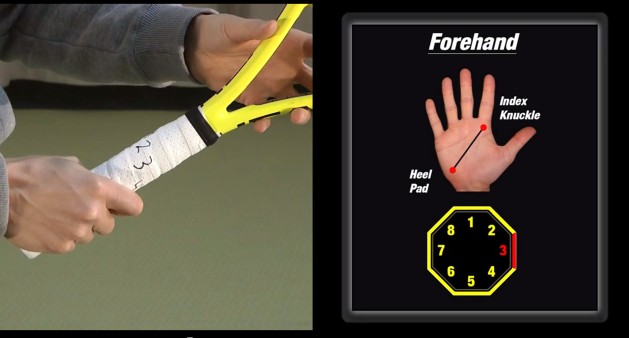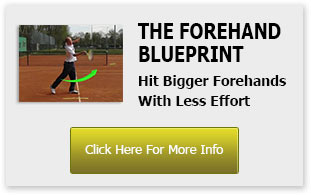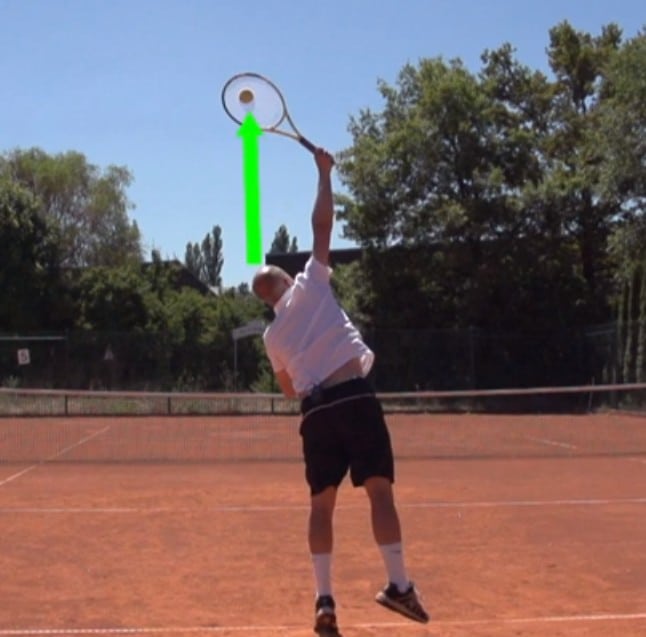Roger Federer hits the best forehand of all-time. His mechanics are absolutely flawless and in this video series I look at what makes his forehand so great as well as what concepts you can apply to your own forehand!
Roger Federer Forehand Analysis Part 1
Video Summary
Welcome to the first part of the Roger Federer Forehand Video Analysis Series. In this series I will take a close look at what makes Roger’s forehand so great and also talk about some of the concepts that you can apply to your own forehand!
With his forehand, Roger can do just about anything he wants from anywhere on the court. He can hit the ball with heavy topspin, he can hit the ball flat, he can create short cross-court angles and he can also block the ball when fast balls are coming into his forehand.
This is in large part due to great technique and it all starts with Roger’s forehand grip.
Roger Federer Forehand Grip
Here you can see an image of Roger with his forehand grip:

This was taken just after a forehand shot, where he still has his forehand grip and has not changed his grip at all. Roger has a very conservative grip with his index knuckle on bevel number 3, which is often called an Eastern forehand grip.
The circle that you see here is Roger’s index knuckle and as we can see it is positioned along the side of the racket on bevel number 3.
Here you can see an image from my tennis grips video where I show the Eastern forehand grip:

On the right side you can see the index knuckle and the heel pad as reference points and bevel number 3 is on the outside of the racket as you can see.
If you have not seen my tennis grips video, I highly recommend you go ahead and watch that one. You can find it on the youtube channel here:
The eastern forehand grip that Roger uses has a lot of advantages. It allows you to effectively deal with low balls as high balls. You can hit flat shots and you can also hit with heavy topspin.
One other big advantage is the fact that from this grip, the switch to your backhand grip goes a lot faster because you have a shorter distance to move your hand. This is a big advantage when you are under time pressure.
Two common examples where this comes into play are the return of serve and when you are dealing with really fast balls, especially on fast surfaces.
Roger Federer Forehand: The Unit Turn
Now that we know about Roger’s forehand grip, let’s take a look at the beginning of his swing, which is the unit turn. Here we see Roger with his feet in the air, just before coming down for his split step:

And here we can see the actual split step:

Now this is the important part. From here Roger is going to start with the unit turn. Roger initiates the backswing by turning his entire body as a unit. Roger turns the shoulders and the hips, until he gets into this fully coiled position:

Roger is really just turning the body and his arms are doing almost nothing. That is a crucial aspect. Most players make the mistake of initiating the backswing with the arm and not using the body enough.
One aspect that really helps with the unit turn is to keep the left hand on the throat of the racket while you are turning. Have a look at how late Roger’s left hand actually leaves the racket.
From this position Roger then straightens out that left arm until it is roughly parallel to the baseline as you can see right here:

This is another crucial position and getting that arm parallel to the baseline really assures that you are properly turning your body. From here Roger is going to let the racket drop and continue with his forward swing, which we will talk about in part 2 of this series.
Ok so much for part 1 of the Roger Federer forehand video analysis series. We talked mainly about Roger’s grip and the unit turn.
If you enjoyed this analysis, please click the like button below and let your tennis friends know about Onlinetennisinstruction.com!





